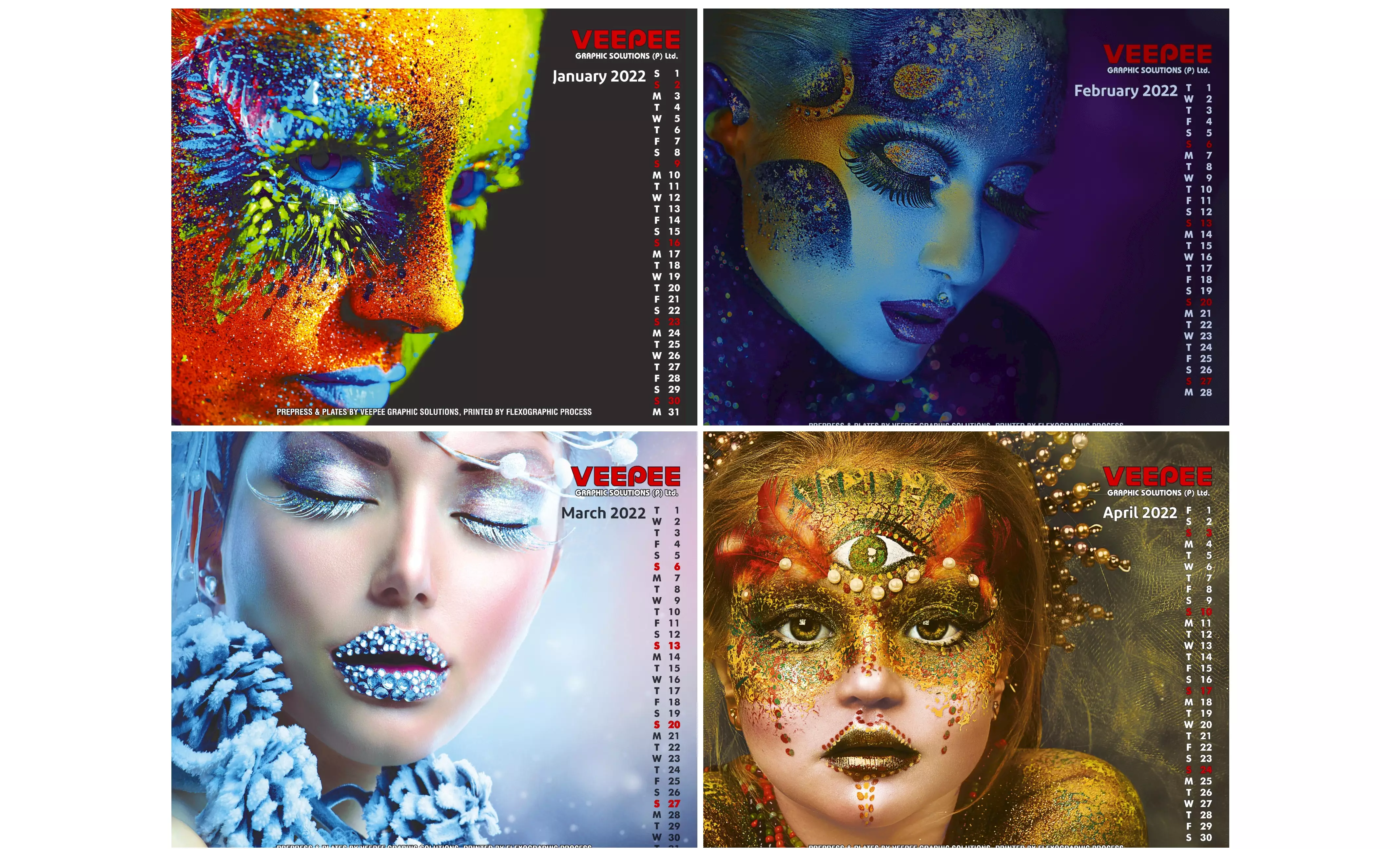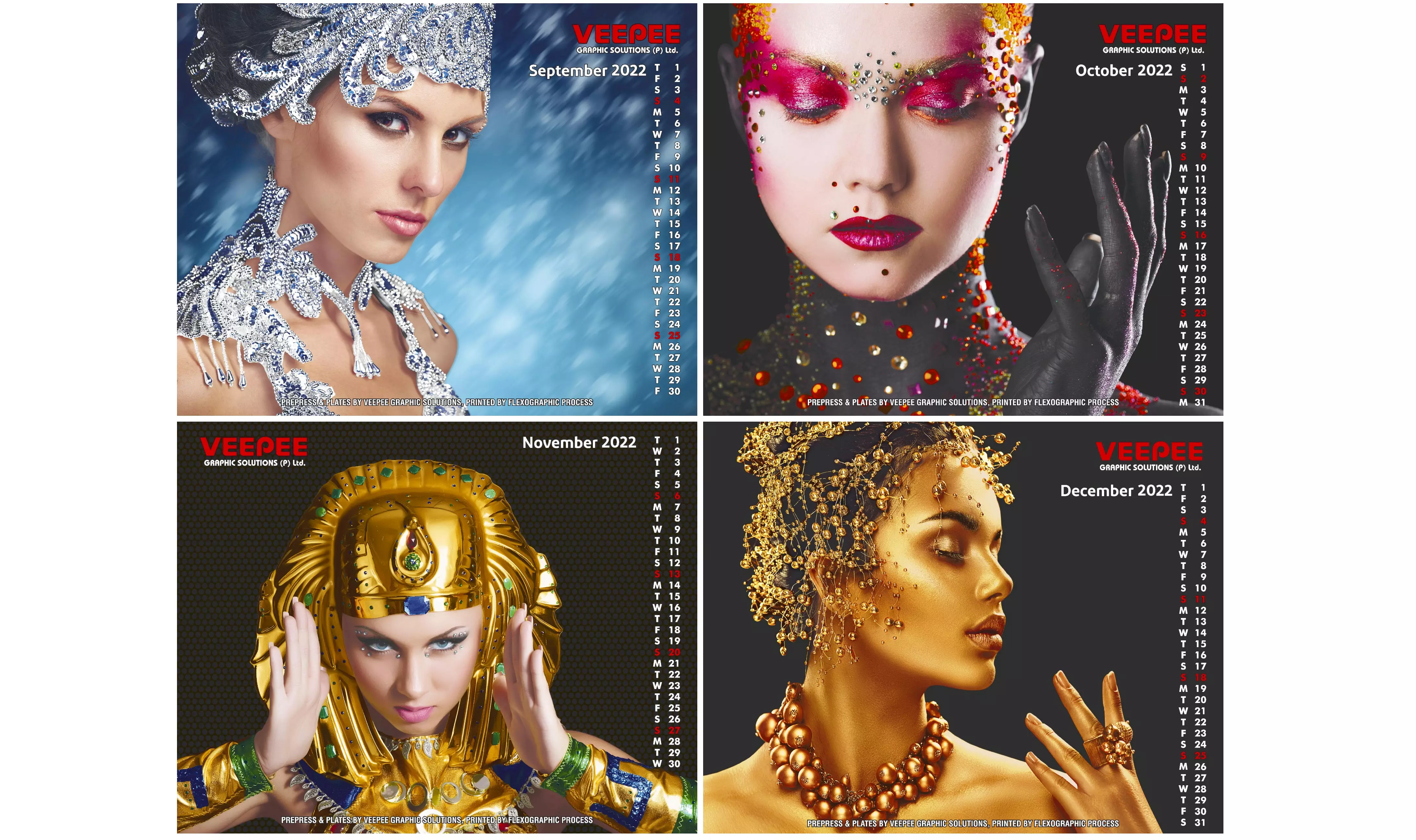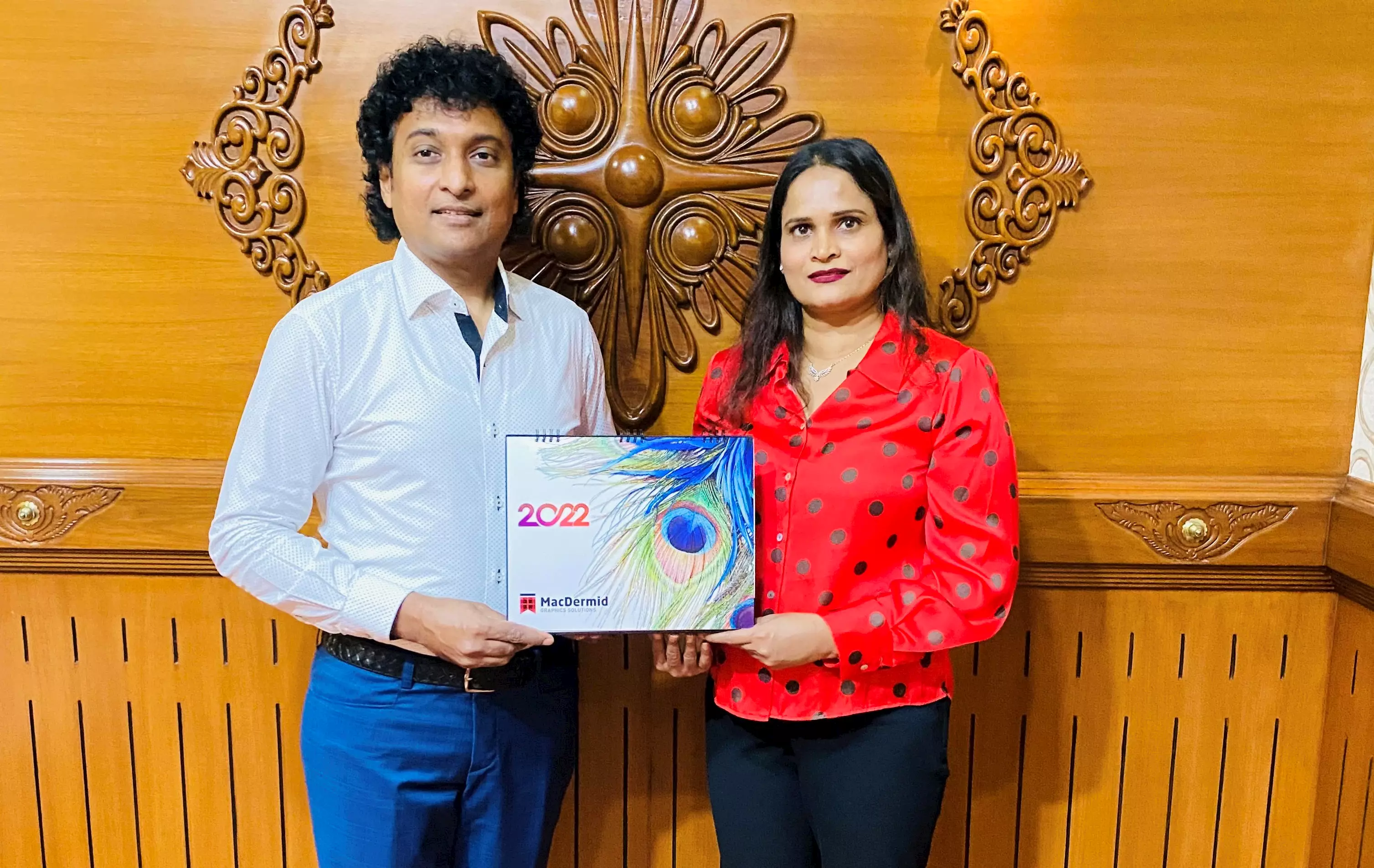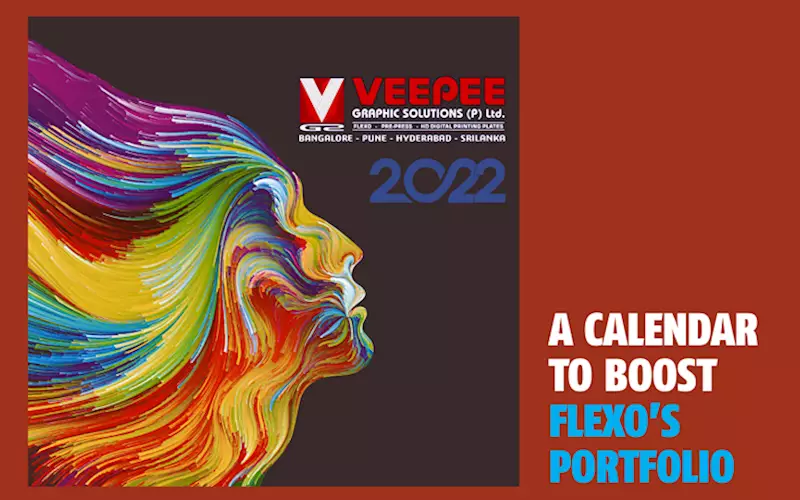A calendar to boost flexo’s portfolio - The Noel D'Cunha Sunday Column
2022 saw the return of the calendars and desk-top calendars. The Sunday Column received calendars from MacDermid, Komori and DuPont. Now, Veepee Graphic Solutions’ tribute to the year, joins the rank.
Jai Chandra, VeePee's managing director, says, viewing the calendar pages is like taking a happy pill. “It's a thousand year old ritual. And in that ritual is a warm woozy feeling which is also the reason for its popularity.” Print business is complex, there are deadlines, risks and vicious blame games. “What better antidote than looking at your own creation, and sharing it with your colleagues,” asks Jai Chandra.
In this Sunday Column, Jai Chandra discusses the reasons why Veepee produced the 2022 calendar
13 Mar 2022 | By Noel D'Cunha
Bengaluru-headquartered Veepee Graphic Solutions is a flexo pre-press specialist with a facility at par with the best in the world. It has a plant in Pune and recently set up another one in Hyderabad. It became the first Indian trade shop to go multinational after it set up a full-fledged pre-press and plate making facility in Sri Lanka in 2016.
So what was the message Veepee wanted to send out with the calendar? Jai Chandra, VeePee's managing director, says he wanted to prove the quality of flexo printing is as good or even better than offset; especially for printing on board. “The folding carton segment which is predominantly an offset dominated market will be the next big business which will move to flexo. This is similar to the transition of the label industry that has transpired over the last ten years.”
Which is why, Jai Chandra and his team unleashed the full force of flexo technology. He laced the finishing to produce a calendar that was based on metallic finish, anti-counterfeit features in print and embellishments with varnish and foil. “We have showcased how flexo can reproduce the sheen and vibrance of gold and silver without metallic inks. The security patterns on the print not only enhance the aesthetic look of the images but also makes it impossible to re-copy,” explains Jai Chandra.
Veepee printed 750 exclusive calendars, but after tremendous success, it realised that 750 was just not enough. “We are getting requests from the industry even now for one set,” says Jai Chandra.
As expected, the calendar was produced using the flexo printing process. While the printing activity took just two days, the whole project from think to ink took about four months.
Jai Chandra explains, “We brain-stormed for a month and finalised the concept. We browsed over 10,000 images to freeze on the final dozen. Visualising the type of embellishments and security patterns to enhance the aesthetic look of the images was another big challenge. I did not want it to look too loud at the same time deviate from the concept of the metalised effect. A 3D rendering of the images with the embellishment was done before it went for the first press proof.”

Resolving the resolution issue
In narrow-web flexo, it is important to determine the screen plate value, line per inch (LPI), and this depends on all the variables. The industry standard average is 120lpi to 175lpi. “The other considerations are, the plate technology, dot gain, and acceptable ratio from the plate screen to anilox cell count,” says Jai Chandra.
Veepee opted for 150lpi, and extended colour gamut (ECG) to achieve a wider colour gamut. Jai Chandra says, “We have used MacDermid ITP 60 plates for this project. With the higher solid ink density and excellent ink transfer capability of the plate, we did not face any challenges as far as the plate is concerned. The press standardisation was done, therefore we were sure of the output even before the job went onto print. There were no major corrections or modifications rendered from the initial machine proof for the final print run. This is thanks to the clean print technology of the ITP 60 plates.”
So, why is the calendar special? “The concept was to reproduce metallic effect without using expensive metallic inks. The substrate used was the same that is used for the folding carton segment. All the embellishments were done in a single pass making it cost-effective and at the same time converted with ease of operation,” explains Jai Chandra.
The flexo press was standardised (Jai Chandra is very particular about this) so that the print results were more predictive even before the plates were made, and the use of ECG ensured that the colours produced were vibrant. “The varnishes used gave the image a third dimension,” says Jai Chandra.

Flexo trends
According to Jai Chandra, the pandemic had disrupted the ecosystem. A lot of brand owners were struggling to get back their market share once the economy opened up. “One of the ways the brands bounced back to business was by enhancing the design elements of the packaging to make it more appealing and also implementing security features to combat the menace of counterfeit. Due to this, we had quite a lot of remakes of plates in the first two quarters of 2021, this was a big boon to the packaging and the allied industries.”
There is a worry (not a trend): how the label industry is coping with competition, by producing labels for as little as a few paise per square inch. It puts a lot of pressure on flexo trade shops to produce plates at a lower cost.
Jai Chandra agrees that the printing and packaging industry in India has always succumbed to price pressure due to the huge number of players in the market. “The growing number has led to huge capacity build-up which is grossly underutilised. This has led to a brutal price war. Being a part of the value chain, the plate suppliers are always under the hammer to reduce the price as most of the converters absorb the development cost.”
He adds, “If we do not find a solution to this, it's sad to say that we will have a lot of trade shops running out of business in the near future. Today the selling price of processed pates in India is one of the lowest in the world.” And then he sighs ...
All about training
Also there are operational issues. As a pre-press pioneer, Jai Chandra knows that there is a skill-set required to produce a quality plate, which will produce a quality print. But what happens when you produce a plate of high standards, but the print result is not up to mark. Where is the problem – press, consumables or operator or a combination of all? How does one solve this conundrum?
Unfortunately in our industry, the first person to be targeted is the plate supplier if the print does not conjure the desired results, says Jai Chandra. “Good technical support and educating the people on the shop floor is the only solution to resolve this issue.”
But over the years we have noticed a positive change in the approach of the operators while resolving print-related issues, thanks to the availability of useful information on the net as well as the technical support offered by all the stakeholders. “At the end of the day it's a combination of the press, substrate, ink, plate and the personnel running the press which is going to make or break the job,” says Jai Chandra.

Meeting the gravure challenge
Producing gravure cylinders is now far easier and quicker than it was. In such a scenario, why should a converter invest in flexo?
Yes, says Jai Chandra, adding, it is rightly said that the cost of making gravure cylinders has considerably reduced as well as the quality is much superior to flexo. “Nevertheless the USP will be savings on the ink cost as the consumption is considerably lower in flexo, lower VOC due to the type of inks used, short set-up times and lower wastage, flexibility to print on different substrates where gravure has limitation.”
For Jai Chandra, the biggest savings from the flexo technology is from the initial investment where a fully loaded flexo press will be far more lower than gravure and the cost of real estate to store the cylinders which require a lot of space. “For short runs with multiple job changeovers, flexo is the only solution.”
One to ponder. And obviously analyse through a cost comparison study.
One reason a study is needed is, brands are not convinced. For some, all said and done, flexo cannot match gravure’s quality. Jai Chandra has an explanation. “Every printing process has its advantages and limitations. Matching gravure quality is definitely a challenge in flexo. We need to convince the brand owners of the other benefits of flexo printing rather than just focusing on the print quality, which no doubt is important.”
The Veepee report card
The last 24 months have been a bit sluggish with some very good months followed by a few bad ones. “Overall, we were in recovery mode after the pandemic,” says Jai Chandra.
The company has set up a new production plant in Hyderabad with a completely new 42x60 line. It has also installed a Crystal XPS plate exposure at its Pune plant in February 2021.
At the Labelexpo Europe show in Brussels, now postponed to September 2023, Jai Chandra had planned to explore new technologies. That search will continue, says Jai Chandra. “The only mantra for survival in this business is update and upgrade or else one is out of business.”
Jai Chandra at a glance

(l-r) Jai Chandra and Nalini Chandra
How do you unwind?
Working out in the gym and a five kilometres run (four times a week). This keeps me sane. Not to mention spending time with my pro golfer daughter Natasha and Nalani, who is more of a friend than being my wife.
One activity you love?
Fingerprinting and press standardisation for my customers, which in most cases, I do free-of-charge.
Favourite films?
Being a hardcore Mallu, I like Malayalam movies. However, Drishyam and Drishyam 2 are one of the best movies of the recent times, while Manichitrathazhu and Thenmavin Kombath are my old time favourite.
Once the pandemic is over, where will you vacation? We did not wait for the pandemic to say adieu. We took a break in Sri Lanka as soon as the country was open for tourists.
Favourite snack in Bengaluru?
I am not a foodie so it's a wrong question to ask me. Yet I love the Obbattu which is a local delicacy made during the festivals.
An international label factory you visited which is a must-see?
Rako in Hamburg. Germany. It is a must-see for every flexo CEO to visit if anyone wants to see 50 narrow-web machines in full production under one roof.
One thing about Bengaluru no one knows?
Bengaluru was once called the Garden City and it was a retired person's paradise.
Who is on your speed dial?
My wife Nalini, of course. There is no one I can think of when I am in trouble. She manages the plate production team and all the four locations report to her. She also takes care of the day-to-day activities and maintenance of all the equipments. As a matter of fact she has installed few machines all by herself during the pandemic when the engineers were not available.











 See All
See All